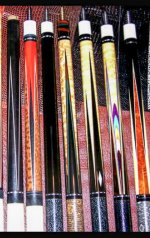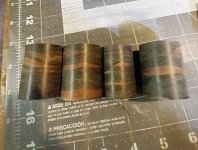Anyone ever make rings out of epoxy? I have two bar cues I'm converting to 2 piece cues and I have very specific colors I'm after. I've looked at all types of material and the only way I can get close is to spend well over $100 on two pieces of material for two cues, I'd rather not do that. During my searches epoxy pigment kept coming up so I bought some and mixed up two colors that are exactly what I want and am going to move forward with it but, I'm curious what sort of issues will come up, either during assembly, finishing, long-term, etc.
I have done extensive research and I haven't found anyone who has ever done this. That could be a good thing or a bad thing so I'm looking for input.
I will add, if it doesn't work out I can always throw it back on the lathe and remove them, not worried about that, just looking for hints/tricks/ideas.
Thanks.
I have done extensive research and I haven't found anyone who has ever done this. That could be a good thing or a bad thing so I'm looking for input.
I will add, if it doesn't work out I can always throw it back on the lathe and remove them, not worried about that, just looking for hints/tricks/ideas.
Thanks.



